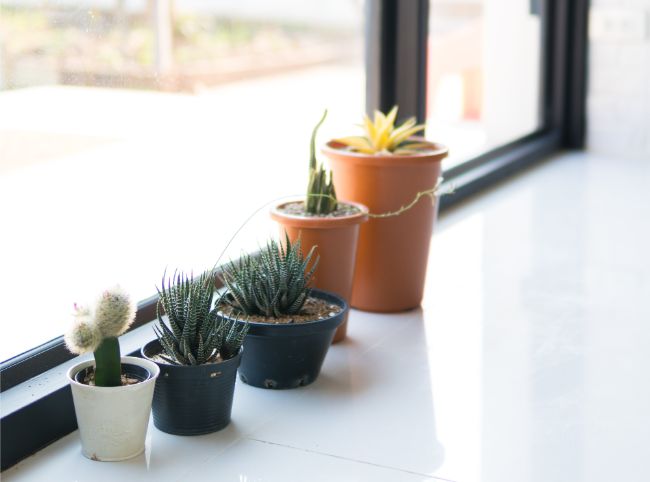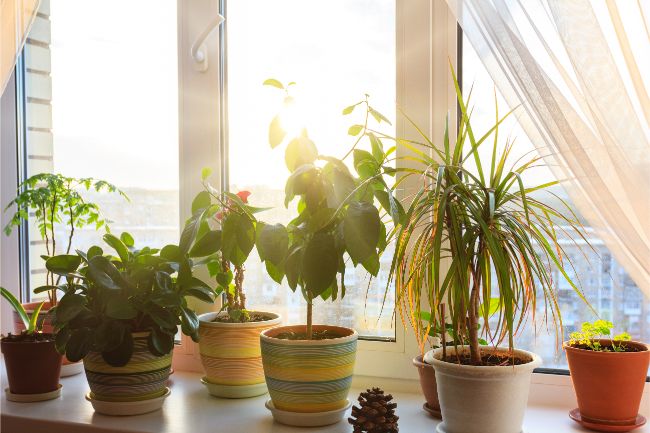Light requirements for indoor plants vary greatly, and many are particularly sensitive to direct sunlight. But is light through a window considered direct sunlight or not? Let’s find out together.
Is light through a window considered direct sunlight? Light through a window is not direct sunlight as some of the light is diffused and reflected as it passes through the window, reducing its intensity. Light through a window is the most direct form of light available indoors, but is usually at least 50% less intense than direct sunlight outdoors.
Getting the lighting right for your indoor plants is crucial to ensure they grow healthily, but you don’t want so much light that they start having problems. Read on to find out how strong light through a window really is.
How Strong Is The Sunlight In My Room?
It’s amazing how much the light levels in your home varies. A plant a few feet from a north facing window often only gets 1% of the light of a plant outside in direct sunlight. With such a range of light intensity, it’s important to get the positioning of your indoor plants right.
Here are some examples to illustrate how much light levels vary depending on where you position your indoor plants.
- Deep Shade: (500–2,500 lux, 50–250 foot-candles) Away from the window of a north facing room: Most plants will struggle, but plants such as cast iron plant, snake plant and chinese evergreen will tolerate these low light conditions.
- Low Light: (2,500–10,000 lux; 250–1,000 foot-candles) Natural light when several feet from an east-facing window on a bright day. Most shade tolerant indoor plants will do well.
- Bright, Indirect Light: (10,000–20,000 lux; 1,000–2,000 foot-candles). Many indoor plants will thrive in these light conditions. A south facing room, out of direct sunlight will usually have bright, indirect light.
- Direct Sunlight Indoors: (20,000–50,000 lux; 2,000–5,000 foot-candles). Many flowering houseplant will thrive in these light conditions. A plant on a south facing windowsill will get approximately this amount of light.
- Direct Sunlight Outside: (40,000–130,000 lux; 4000 foot candles+). Usually more than twice as strong as direct sunlight through a window. Plants moved from an inside location to an outside location often need to be acclimatized to the increased light.
Why Is Light Through A Window Not As Strong As Direct Sunlight Outdoors?
When you are standing outside, and it is cloudy, the rays that are filtered through the clouds are not considered direct light. Similarly, when you are standing under a tree, the light that hits you through the branches and leaves is not considered direct light.
The same concept applies to sunlight coming in through a window. The light passes through the glass barrier of the window and loses some of the light and energy intensity as it does so. The light has been refracted, some has been reflected and some has been scattered, reducing the intensity of the light.
Just like a rainbow, sunlight is also made up of different colored rays. When these rays are together, they produce sunlight in its full potential. When the light passes through something, whether a cloud or through a window, it loses some of its strength, either via reflection or diffusion.

Different Types of Light Through A Window
There are different intensities of light that filter through a window. Each of these lights depends on the location of your window as well as if there are any barriers between the sun and your window, both indoors and outdoors.
Location
When talking about location, it is not only the direction of the window that matters but also the influence of different seasons. The amount of light and the intensity are different in warmer compared to colder months.
North Facing Windows
North facing windows never receive direct sunlight through them due to the path of the sun, which rises in the east, travels across the southern half of the sky and sets in the west. A north facing window sill will be suitable for shade tolerant plants, and away from the window of a north facing room, only very shade tolerant plants will thrive.
I’ve written an article which covers 21 plants that are ideal to grow in North facing windows. You’ll be surprised by how many amazing and beautiful indoor plants love north facing rooms and thrive in lower light conditions.
If you really want to grow plants that need high light levels in a north facing room, try to get them as close to the window as possible, or consider using a grow light to boost light levels, particularly in the winter.
South Facing Windows
These tend to be the warmest and brightest spots in the house. The intensity of the light is felt throughout the day because the sun is always shining in this part of the house. Whether it is early morning when the sun is just rising or the evening when the sun is setting.
Most plants can do very well in south facing rooms. Light loving plants like cacti, many succulents, euphorbia milii, citrus plants and anthuriums can all do well in south facing windows. Keep lower light houseplants away from the window and provide shading to keep them out of direct sunlight.
East Facing Windows
This is the best place in the house for plants that require medium sunlight or morning sunlight since this is the first spot the early morning light will hit. This area also tends to be the cooler as the sun makes its way west.
East facing windows are ideal for a large range of indoor plants. They receive some direct morning sunlight, but avoid hot direct sunlight of the middle of the day.
West Facing Windows
This is the area that gets the most-light after midday and it is also the warmest part since the sun keeps shining in this area from midday until it sets in the evenings. So, if you have plants that need a lot of light, this is another great spot for them.
I love to keep plants that love bright conditions in west facing windows. They avoid the most intense direct sunlight, but still get plenty of bright light.
Barriers
These can be of two types; either indoor or outdoor, and they both do the exact same thing. They filter direct sunlight and make it indirect light.
- Indoor Barriers: Windows themselves, blinds, curtains and furniture are all barriers that block some or all of the light reaching your plants.
Using barriers to your advantage can help your plants get the perfect amount of light. Putting a sheer curtain in front of a south facing window, or moving a plant into the shade of some furniture can adjust the light from being intolerable to perfect.
- Outdoor Barriers: There are many outdoor barriers that are readily found in nature. These could be anywhere from trees to clouds to a gazebo.
Any of these natural elements that prevent sunlight from hitting you or the plants directly is considered an outdoor barrier. These are less adjustable, but you should still consider them when assessing your room, ideally before choosing which plants to place in your home.
Why Is light Intensity Important For Houseplants?
Plants need sunlight so they can go through their natural process of photosynthesis. Plants need sunlight to help them convert carbon dioxide and water into plant food, sugar, and starch. Without sunlight, plants can only survive for so long. Read my article about whether plants can survive without sunlight for more information.
Not all plants need the same amount of sunlight. Some plants need more sunlight like many flowering plants. While many leafy green plants need less sunlight. So knowing what kind of light your plant needs helps you maintain them.
One more thing to note: Most people like to choose a plant they like for their home or office and then they choose a spot for that plant in their space. It is much better to do the opposite.
First, choose a spot where you would like your plants to go, then choose a plant. This way, you know exactly how much light comes through to that spot. If it’s warm, if it’s dark, if it’s bright, etc. all of these factors will help you determine the best plant for that area.
This, in turn, will help you make sure that you take care of that plant appropriately so that the plant not only survives but thrives.
Last Word
Light passing through a window is considerably less strong than direct sunlight outdoors. Most houseplant care guides will refer to light through a window as direct sunlight. Despite the reduced intensity, it can still cause your plants to get burnt if you are exposed to the light that is coming through that window directly.

